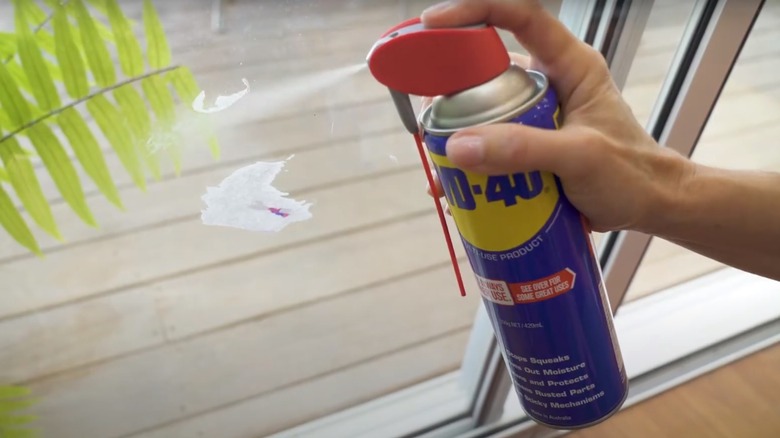A Household Staple Will Help Keep Paint From Getting On Your Doorknobs
When painting a door or cabinet, you either need to remove all hardware before beginning, or place masking tape over the handles and doorknobs. Unscrewing all that hardware can take a long time, but should you leave the hinges and hardware on, you risk getting errant drips of paint on them, creating a mess. But it can be difficult to put tape on your hardware because of its odd shape and curves. Thankfully, there's another option: You can spray WD-40 over your metal hardware, which prevents runaway paint from sticking to it. When it's time to clean up, just wipe down the hardware with a clean cloth or paper towel, and any extra paint will simply be wiped away.
The use of WD-40 keeps your home mess-free in all kinds of ways, like using it to remove scuff marks from the floor, eliminate sticky residue from plastic, and erase crayons from wallpaper. But it's great to use when painting too, in order to protect the hardware on your doors and cabinetry. Here's how.
How to use WD-40 to protect hardware and doorknobs when painting
When painting a door, it's easy to miss the edge and end up applying paint to spots where it's not welcome, but WD-40 acts as a barrier for these areas and ensures paint won't stick to them. When applying it, it's important to only spray the solvent onto the parts of door or cabinet where you don't want paint – if the WD-40 ends up on the paintable surface itself, the paint will not adhere well to that section. Use the straw that comes with a WD-40 can so that you can be as accurate as possible when applying.
Hold the end of the straw an inch away from the item you want to coat and give the nozzle a quick press. You just need a light coating of the solvent to prevent paint from sticking to the metal pieces. If you apply too much WD-40, it can drip or run onto areas of the door or cabinet where you don't want it. If this happens, use a rag to wipe it away as quickly as possible. For extra-small knobs or handles where the straw isn't precise enough, spray some of the solvent onto a clean rag, and use the rag to apply it onto the hardware. Once you've finished painting, wipe away the WD-40 and any paint drips that have landed on it.
Other ways to use WD-40 to clean up after painting
Even if you decide to use masking tape on the metal doorknobs and handles rather than WD-40, you can still use the solvent to help with the cleanup process afterward. If you end up with paint or sticky residue from the tape on the surface itself or its hardware, spray the area with WD-40. Let it sit for a minute or so before using a plastic putty knife to wipe away the remaining residue. Reapply as needed, and use a clean rag to remove any remaining WD-40 once finished. You should wait until the paint is completely dry before using the solvent, or it could end up affecting the quality of the paint job. You should also test the WD-40 in an inconspicuous area of the metal or glass before using it, just in case it has an adverse reaction with the coating of the metal or glass.


